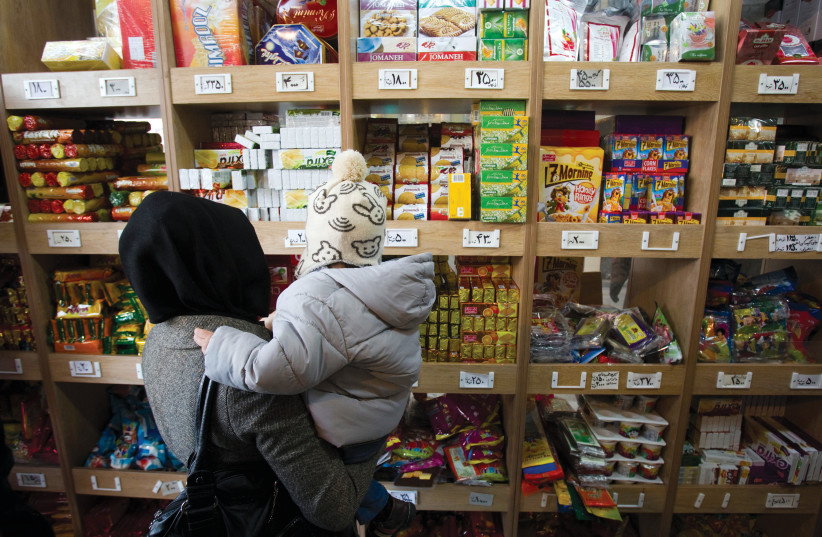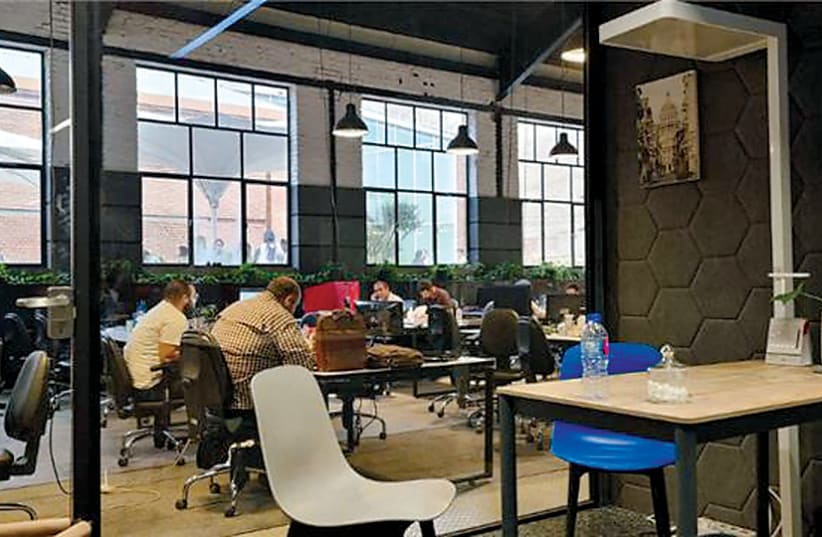
It is easy to paint a dark picture of Iran’s economy: high inflation, plunging currency, unemployment, bureaucracy, sanctions.
But beneath the red ink lie strong universities, advanced technology, and innovative start-ups. And a giant economy and population, whose size alone makes it formidable.
Economy & population
Iran has 86,758.304 people. Its gross domestic product (GDP) is nearly $2 trillion, 11th largest in the world.
After the Trump administration reimposed economic sanctions, Iran’s GDP declined in 2018 and 2019 but grew in 2020 (1.8%) and in 2021 (4.0%).
GDP per capita is $18,803, measured in terms of purchasing power parity (i.e., using an exchange rate that reflects the currency’s true value). Israel’s GDP per capita is $52,000, almost three times higher.


Both inflation and unemployment are high. Consumer prices rose by 34% in 2020. In that year, unemployment was 16%. Only a little over one-third of the population over age 15 is in the labor force and employed. This is due to very low female labor force participation; only 14% of adult women are in the workforce.
Poverty is widespread. More than half the population lives below the poverty line. One person in nine lives on less than $5.50 a day. There is a particularly large urban-rural gap. Urban households earn 70% more than rural ones.
Doing business in Iran
It is hard to do business in Iran. According to the World Bank, Iran’s “ease of doing business” index ranks 127th. And according to the Heritage Foundation, Iran’s economic freedom score (measuring how free and open the markets are) ranked 170th in 2022 – lowest in the Mideast and North Africa, and falling.
“The quality and availability of administrative services by the state,” notes the Heritage Foundation, “are constrained by mismanagement, bribery and rampant corruption… Powerful institutions such as the Revolutionary Guard limit fair competition and entrepreneurial opportunities.”
“The quality and availability of administrative services by the state are constrained by mismanagement, bribery and rampant corruption… Powerful institutions such as the Revolutionary Guard limit fair competition and entrepreneurial opportunities.”
Heritage Foundation
Iran trades mainly with China, India and the UAE. Some 60% of Iran’s exports, mostly oil and gas, go to China and India, and nearly 40% of its imports. Public debt is low, at 40% of GDP; Iran is limited in its ability to borrow abroad by its low credit rating (CCC). Its budget is in surplus, amounting to 3% of GDP.
Iran has a chronically weak and undercapitalized banking system and an anemic public sector. It is considered an energy superpower, with 10% of the world’s proven oil reserves (fourth largest) and 15% of world gas reserves (second largest).
Iran’s stock market rose sharply in 2020, reaching an all-time high in August, as retail investors (the general public) “piled in,” but it has since given up part of its gains.
During the COVID pandemic, Iran suffered 129,000 deaths – significantly fewer per capita than the US.
American sanctions have been a fact of life for Iran, since 1979, with a brief pause, curtailing Iran’s crucial oil exports. This has caused the external value of the rial to plummet. To buy one dollar, you need 42,000 Iranian rials. A Coca-Cola costs 60,000 rials.
Yet the Iranian economy has been resilient. Iran still exports hundreds of thousands of barrels of oil daily, mainly to China. And the weak rial and sanctions have helped Iran’s manufacturers to substitute local goods for imported ones.
Science, technology & innovation
Iran has at least 21 major universities, and close to five million undergraduate students. This has been termed an “over-education crisis” because graduates struggle to find employment. Five of its universities rank among the leading 1,000 in the world, led by the University of Tehran.
According to the 2022 Global Innovation Index, Iran ranks 53rd among 132 countries, up strongly from 67th in 2020. (For comparison, Israel ranks 16th). Iran ranks their among the 30 lower-middle-income countries.
Iran’s research output has grown dramatically. The number of scientific publications increased by 73% between 2011 and 2019. Biotech publications, in particular, grew by two-thirds.
Iran scientists publish more than twice as many articles as their Israeli counterparts. But per capita, Israel leads by a wide margin, ranking 14th in the world, compared to Iran’s 30th.
Until recently, Iran had a thriving start-up sector. However, according to the Al-Monitor website, the Washington-base source of reliable Mideast news, “The domestic wave of social protests, the government’s crackdown, and related Internet restrictions have negatively impacted the country’s start-up scene and will lead to the closure of many innovative entities….only larger and more consolidated entities will manage to survive.”
Iran is constructing a new super-computer. It is reported to be 100 times more powerful than existing ones in Iran and has been given the name Maryam. It is named after Maryam Mirzakhani, a professor of mathematics at Stanford University who won the Fields Medal in 2014, the most prestigious award in mathematics.
Iran successfully put its first military satellite into orbit in April 2020. Times of Israel reports that Iran prepares to launch “at least two satellites” into space by late March. The US protested that such launches could boost Iran’s ballistic missile technology, enabling potential delivery of nuclear warheads.
On December 25, Zohar Palti, a former intelligence director in the Mossad, said Iran was mere days or weeks away from enriching uranium to 90% military-grade levels required for the production of nuclear weapons.
Someone once said, “Listen to your enemies – they have a case.” Iran is by far Israel’s most formidable foe. Its subliminal case against Israel? Israel, a Jewish state, embarrasses Iran, a Shi’a Muslim state, by being a modern, wealthy, successful Mideast nation driven by brainpower – something Iran aspires to but falls short of.
There is no room for complacency. Iran will remain a growing threat for years to come. ■
The writer heads the Zvi Griliches Research Data Center at S. Neaman Institute, Technion and blogs at www.timnovate.wordpress.com. Ella Barzani assisted with research for this column.
